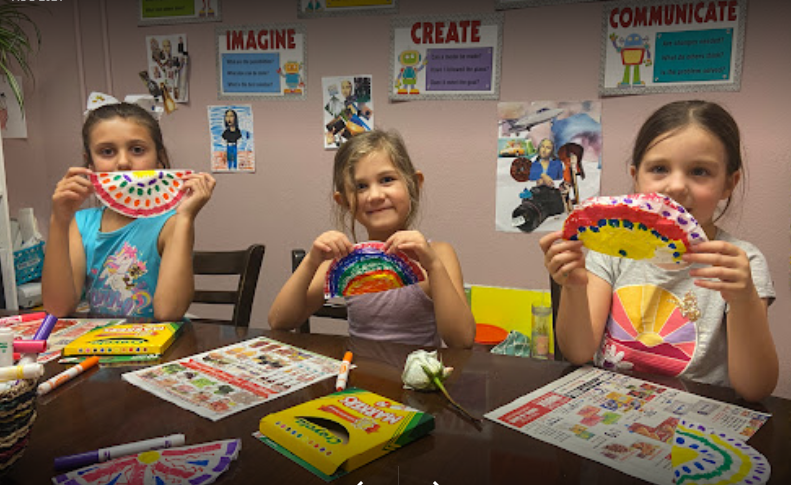
Bloom Academy in Las Vegas, Nevada, available to children ages 5 to 14 from all socioeconomic backgrounds, benefited from the resources and guidance provided by National Microschooling Center to fine-tune its self-directed learning approach. The academy’s philosophy is based on the idea that children are natural learners who should have unlimited opportunities to play, make mistakes, and develop their interests.
Editor's note: In keeping with our year-end tradition, the team at reimaginED reviewed our work over the past 12 months to find stories and commentaries that represent our best content of 2022. This post from newsfeature writer Tom Jackson is the seventh in our series.
 It’s well documented that millions of parents turned to microschools as a result of campus shutdowns during the long Covid-19 nightmare. These nimble learning centers provided safe gathering spaces and tailored learning experiences for cast-adrift students and comported with parents’ work demands.
It’s well documented that millions of parents turned to microschools as a result of campus shutdowns during the long Covid-19 nightmare. These nimble learning centers provided safe gathering spaces and tailored learning experiences for cast-adrift students and comported with parents’ work demands.
More than two years later, what had at first seemed a temporary salve born of desperation looks more like a godsend to a long-festering problem. Writing for the Manhattan Institute, researcher Michael McShane lays out the framework and the appeal of microschools:
Neither homeschooling nor traditional schooling, [microschools] exist in a hard-to-classify space between formal and informal learning environments. They rose in popularity during the pandemic as families sought alternative educational options that could meet social-distancing recommendations.
But what they offer in terms of personalization, community building, schedules, calendars, and the delivery of instruction will have appeal long after Covid recedes.
Long-time education choice advocate Don Soifer concurs.
“For whatever reason, families are just rethinking the public education system,” he says. “The research is telling us now that microschooling serves 2-1/2 to 3-1/2 million learners as their primary form of education.”
That puts microschoolers at about 2% of the national student population, a number higher than K-12 Catholic school enrollees, according to the Center on Reinventing Public Education.
“It really wouldn’t surprise us at all to see microschools capture 10 percent of market share,” Soifer says.
In short, microschooling is no flash-in-the-pandemic phenomenon. In response and anticipation – and backed by Stand Together Trust – Soifer launched just last week the National Microschooling Center, a Las Vegas, Nev.-based resource hub designed to provide a smorgasbord of resources and technical assistance in support of the growing wave of tiny learning environments across America.
Soifer’s credentials for the task are as impeccable as his interest is diverse. Active in President George W. Bush’s No Child Left Behind initiative, he served on charter school boards in Washington, D.C., and Nevada, and has been president of Nevada Action for School Options since September 2017.
At the start of the pandemic, Soifer and his team partnered with the city of North Las Vegas to create the Southern Nevada Urban Micro Academy, which opened in August 2020. It’s not often the local media uniformly praise anything, Soifer noted, but with academic scores surging amid students, parents, educators, and lawmakers who found themselves uniformly delighted, SNUMA managed to harmonize even the typically rancorous media choir.
Notable, says National Microschooling Center chief innovation officer Ashley Campbell, is how quickly the students adapted, then thrived.
“It was so exciting to watch the transformation of the children as they … [had] the chance to own their own education, follow their own learning trajectory, set their own goals, and live up to those goals,” Campbell said.
“It was amazing to watch a group of fifth- and sixth-grade students shift from a place where learning wasn't cool, it wasn't cool to be smart, to a place where they were encouraging each other to meet their goals and exceed them.”
The year’s contagion wasn’t confined to Covid-19, it turns out.
“Movement-building is a gradual process, and frankly one that the school choice movement has had mixed success over time in doing,” Soifer says. “And even that success is different in particular jurisdictions. But as people have become familiar with this different way of learning — in ways that public schools don’t encourage — it gets to be popular. And that makes for concerted, dedicated, sustained movement-building.”
The prevailing menu of microschools comes in three forms: independent (standalone pods or centers), partnership (with a public, private, or sectarian entity), and corporate (such as KaiPod Learning or Prenda). National Microschooling Center is designed to increase the momentum for all of them in four key ways: by cultivating and growing demand; by building and strengthening microschool leader capacity; by driving growth-friendly policies; and by mobilizing united communities of practice.
“It’s really important to note that we’re not talking about taking a model that works here and placing it somewhere else,” Soifer says. “If you’re a microschool that wants support and resources, we’re not going to require you to follow a design. It’s about building a program to meet the needs of your particular learners, equipping your leaders for success, and making sure they know how to build relationships with families.”
In other words, he says, it’s not about the center saying, “Here’s the model and let’s stick to it.”
Prioritizing bespoke learning conditions is how Soifer’s group has acted at the local level, says Sarah Tavernetti, principal of Bloom Academy in Las Vegas.
“We don't do testing. Or grading,” she says. “What else? There’s no homework, we don't implement a curriculum, so we're fully self-directed.”
Rather than telling students what they’re going to learn about, Bloom Academy encourages them to let their curiosities and natural inclinations guide their day.
“We’re here to support them, bring in people from the community who are knowledgeable about the things that they're interested in,” Tavernetti adds.
Some students attend Bloom Academy full time, some part time, some as part of their homeschool program.
“We’re kind of this umbrella for all those different philosophies,” Tavernetti says.
And Team Soifer is perfectly okay with that.
“Don and Ashley started out as advisors,” Tavernetti says. “Now we think of them as friends.”
Plainly, then, what the National Microschooling Center won’t do is require schools to purchase particular curricula or licenses or get locked into a contract. Instead, the center offers resources and guidance, plus the opportunity for connectedness — mobilizing united communities of practice.
Education, in every form, often leaves practitioners with the sense that “they’re out on an island doing their own thing,” Campbell says. “Teachers spend their day in the classroom with the kids, and they rarely have a chance to talk to other adults.
“We’re making sure that our microschool leaders are not feeling isolated, that they’re able to come together, brainstorm with each other, and solve problems together.”
But the bigger picture is never far from Soifer’s mind. Topping the National Microschooling Center’s action plan is energizing and organizing a coast-to-coast school-choice advocacy movement. There’s already good news on that front, especially in Arizona, but also in Florida, Indiana, and West Virginia.
But even in less choice-friendly Georgia, microschools are thriving in and around Atlanta. It’s all about understanding the lay of the land, Soifer says, and working the topography to your best advantage.
“There’s energy here like we haven’t seen,” he says. “And [microschools] don’t compete with each other; they really want to see each other succeed and thrive.”
If that’s truly the case, National Microschooling Center has arrived on the scene at precisely the right moment.